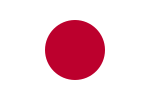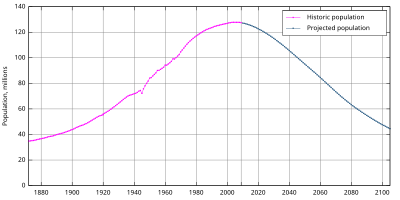| This article may need to be rewritten to comply with Misplaced Pages's quality standards. You can help. The talk page may contain suggestions. (July 2013) |
| This article is part of the series |
| Decades in Japan |
|---|
 |
The 2000s in Japan began with hope and optimism for the 21st century and ended with the late-2000s recession.
Gaming systems like the PlayStation 3, the Wii, and the Nintendo DS continued to help generate the profits of Japan-based electronic companies like Nintendo and Sony. Video games released and/or developed in Japan would see an improvement with their physics engines, their artificial intelligence, and see their graphics become high definition. Many young people would live with their parents and spend their time reading manga and watching anime due to the lack of employment for young people in Japan during this decade.
The average price of gasoline at the end of the 2000s would be $8/gallon; making it unaffordable for most Japanese people to drive long distances unless necessary.
Some examples of anime of the 2000s would include Bleach, One Piece, Kirby of the Stars, Sonic X, Tokyo Mew Mew, Ojamajo Doremi, Gurren Lagann, and Kodai Ōja Kyōryū Kingu. Most of these anime shows mentioned here would also go on to relative success in North America and Europe in the 2000s. For example, Tokyo Mew Mew became Mew Mew Power while Ojamajo Doremi became Magical Doremi.
Social
Employment
See also: Labor market of JapanWhile people were losing their jobs, technology still was advancing at an exponential rate - making more jobs obsolete as new technologies replaced the old. Manufacturing jobs were being replaced with service sector jobs just like they were doing in the Western countries—leading to people being underemployed in either minimum wage or near-minimum wage jobs. There was some economic recovery during this decade; but the spending on cars and whiskey had not returned to the levels that were reached during the Japanese economic boom of the 1980s. Japanese employers and companies made up for the labor shortages in the 1990s by hiring temporary workers without security or job benefits.
As of March 2010, the unemployment rate in Japan is 4.9%; a very low number compared to the unemployment rate during the height of the Lost Decade. The Lost Decade would finally come to a close in the year 2000; marking a decade of economic renewal after a gradual recession.
Cell phone usage
Japan has more multi-function cell phones than any other nation on earth during this decade. Handsets that are available often double as televisions and subway passes. They can also be used to buy sodas and beer from vending machines or conduct banking. Japanese people of this decade are more likely to send e-mails, messages and play games on their cell phones instead of using them to talk to people. Teenagers listen to music and surf the Internet for vital information. Girls often go to restrooms to send progress reports about dates to their friends. Poets and musicians write down thoughts in their cell phones and memorize them for work or home. Young kids are e-mailed by their parents or their guardians about their whereabouts. Expert cell phone users can type 100 Chinese characters per minute (the equivalent of 100 words per minute in the English language).
Young women between the ages of 10 and 19 spend almost one hundred minutes (1.65 hours) a day on a cell phone; compared to the national average of 18 minutes. People use cell phones in Japan to find apartments for rent, follow the results of each and every Sumo match, download horoscopes, and check out the most popular pop music songs on the charts. Kanji is now used less frequently thanks to cell phones; leading to a dumbing down of the Japanese language. Cell phones in Japan are arguably the world's most advanced. However, most models do not work outside Japan. Many use their cell phones to tap to into service that send messages about bargain prices. The Japanese even use their cell phones to do grocery shopping. Sales using cell phones have increased by 51.4 billion yen from 2003 to 2004.
Population decline
See also: Aging of JapanThe 1990s were the final decade where the birth rate in Japan would exceed the death rate. Young people lacking money and living space to properly reproduce is just one of many reasons the birth rate plummeted starting in the year 2005. It has been suggested that the population of Japan will fall from over 100 million in the 1990s to a mere 95.2 million by the year 2050. However, the most recent rise in the national birth rate of Japan happened in February 2007. Japan will see a 0.9% decline of their population after the year 2025 - lowering their labor force while countries like Canada will see a rise in their labor force by that same year. More than 100000 new jobs were added in Canada by the end of April 2010 alone.
Shimojō, a village in the prefecture of Nagano, has an approximate population of 4169. This village is the only Japanese municipality in this decade to contradict the national population decline in Japan. The birthrate in the area was 2.12 (compared to the national average of 1.25) in 2005. There is a density of 110.70 people per square kilometre in Shimojō and the total area of the village is 37.66 square kilometres (9,310 acres).
Images


See also
References
- "PS3 sells out at launch". BBC. 2006-11-11. Archived from the original on 17 December 2007. Retrieved 2008-01-14.
- Sanders, Kathleen (September 13, 2006) Japanese Wii Price, Release Date Revealed Archived 2007-02-19 at the Wayback Machine, ign.com
- "IGN: NDS Japanese Launch Details". 7 October 2004. Archived from the original on 3 January 2009. Retrieved 2008-12-27.
- "Academic AI and video games" (PDF). 2005. Archived (PDF) from the original on 24 August 2007. Retrieved 2007-09-26.
- "Source engine". n.d. Archived from the original on 21 August 2007. Retrieved 2007-09-26.
- Young people in Japan during the 2000s Archived 2010-01-04 at the Wayback Machine Facts and Details. URL Accessed May 18, 2010.
- When Gas Hits $20 Per Gallon
- "Official Japanese site at HICBC". Archived from the original on 2017-06-01. Retrieved October 28, 2006.
- "Official Tokyo Mew Mew episode list" (in Japanese). TV Aichi. Archived from the original on January 13, 2008. Retrieved March 9, 2008.
- "Japan's unemployment rate falls in January - Yahoo! News". Archived from the original on 2010-03-08. Retrieved 2017-01-13.
- Hayashi, Fumio (2001). "The 1990s in Japan: A Lost Decade" (PDF). fhayashi.fc2web.com. Retrieved 2019-07-11.
- ^ "Cell phone usage in Japan". Archived from the original on 2011-07-10. Retrieved 2010-05-18.
- Japan's Elderly Population Rises to Record, Government Says Bloomberg.
- "日本の将来推計人口(平成14年1月推計)について". Archived from the original on 2010-01-13. Retrieved 2010-05-18.
- Paul S. Hewitt (2002). "Depopulation and Ageing in Europe and Japan: The Hazardous Transition to a Labor Shortage Economy". International Politics and Society. Archived from the original on 27 December 2007. Retrieved 2007-12-15.
- Canadian, The (2010-05-31). "109000 fewer jobless people in Canada". Baystreet.money.ca.msn.com. Archived from the original on 29 May 2010. Retrieved 2010-05-31.
- ^ Kohei, Yano. "'Another Road' Shown by Small Villages - Ooshika & Shimojo in Nagano Pref." Japan Spotlight: Economy, Culture & History. (2007).